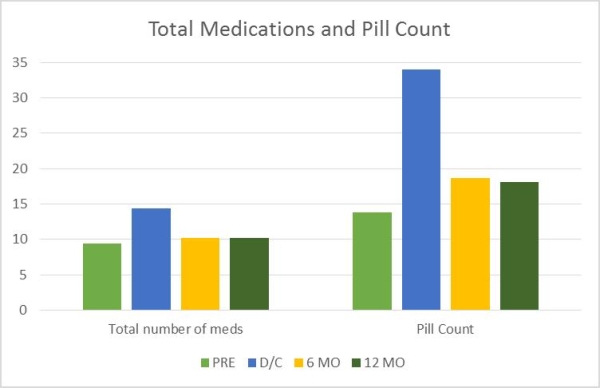Analyzing Transplant Medication Myths
R. Krislock, J. Brandenberger, P. Stracener, A. Weiss, K. Wipperling, C. Kuhr.
Division of Transplant, Virginia Mason Medical Center, Seattle, WA.
Meeting: 2018 American Transplant Congress
Abstract number: C294
Keywords: Immunosuppression, Kidney transplantation, Kidney/pancreas transplantation, Psychosocial
Session Information
Session Name: Poster Session C: Psychosocial and Treatment Adherence
Session Type: Poster Session
Date: Monday, June 4, 2018
Session Time: 6:00pm-7:00pm
 Presentation Time: 6:00pm-7:00pm
Presentation Time: 6:00pm-7:00pm
Location: Hall 4EF
Patients may misconstrue the amount of medications required for transplantation, expecting to take “handfuls” of medications for life. This study aims to determine the change in number and type of medications kidney and kidney-pancreas transplant (SPK) recipients are prescribed before and after transplantation.
This is a single center retrospective review including 76 patients transplanted 10/1/2015 – 9/31/2016 at Virginia Mason. We identified the number of medications these patients were taking prior to transplant, at time of discharge from hospitalization for transplant surgery, and at 6 month and one year follow-up visits.
Immediately after transplantation, patients are prescribed approximately 5 more medications compared to the pre-transplant period (+4.87, 95% CI 4.00-5.74). By 6 months after transplant, this number drops to approximately the same number of medications patients take before transplant (10.26 v. 9.43).  Of the patients with follow-up at 6 months (N = 69), the change in number of prescriptions from prior to transplant to 6 months was +1.13 (95% CI 0.11-2.15). Of the patients with follow-up at 12 months (N = 66), the change in number of prescriptions from prior to transplant to 12 months averaged +1.26 (95% CI 0.25-2.27). SPK patients experienced a similar change. Pill burden is very high at the time of discharge from index hospitalization, averaging 33.97 pills per day. Pill burden declines to 18.62 pills 6 months post-transplant and 18.09 pills at 12 months post-transplant, which remains higher than before transplant (13.79). Anti-hypertensives and medications for calcium / phosphorus homeostasis are commonly used for ESRD. Immunosuppressive medications and GI medications are the most common types of medications prescribed after transplantation.
Of the patients with follow-up at 6 months (N = 69), the change in number of prescriptions from prior to transplant to 6 months was +1.13 (95% CI 0.11-2.15). Of the patients with follow-up at 12 months (N = 66), the change in number of prescriptions from prior to transplant to 12 months averaged +1.26 (95% CI 0.25-2.27). SPK patients experienced a similar change. Pill burden is very high at the time of discharge from index hospitalization, averaging 33.97 pills per day. Pill burden declines to 18.62 pills 6 months post-transplant and 18.09 pills at 12 months post-transplant, which remains higher than before transplant (13.79). Anti-hypertensives and medications for calcium / phosphorus homeostasis are commonly used for ESRD. Immunosuppressive medications and GI medications are the most common types of medications prescribed after transplantation.
By 6 months after transplant patients must manage only one additional prescription on average, yet pill burden is high. High pill burden is associated with reduced medication adherence in many chronic disease states including hypertension, HIV/AIDS, diabetes, and ESRD. The high pill burden for transplant patients is one reason they benefit from ongoing support from a transplant pharmacist.
CITATION INFORMATION: Krislock R., Brandenberger J., Stracener P., Weiss A., Wipperling K., Kuhr C. Analyzing Transplant Medication Myths Am J Transplant. 2017;17 (suppl 3).
To cite this abstract in AMA style:
Krislock R, Brandenberger J, Stracener P, Weiss A, Wipperling K, Kuhr C. Analyzing Transplant Medication Myths [abstract]. https://atcmeetingabstracts.com/abstract/analyzing-transplant-medication-myths/. Accessed December 20, 2025.« Back to 2018 American Transplant Congress
